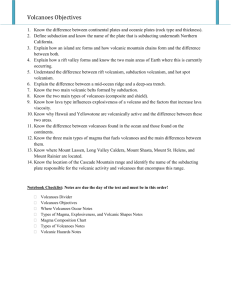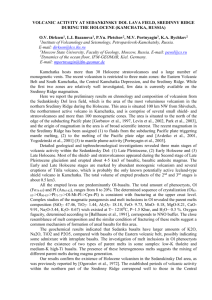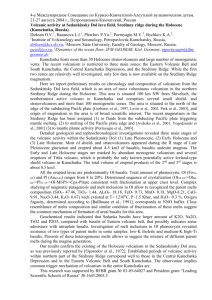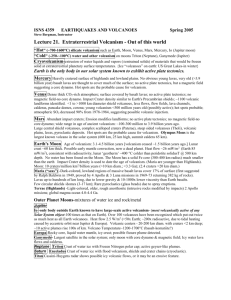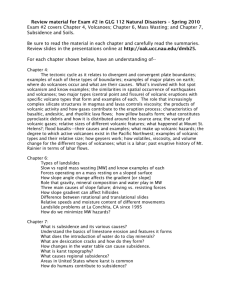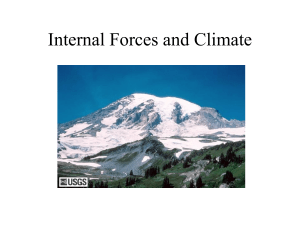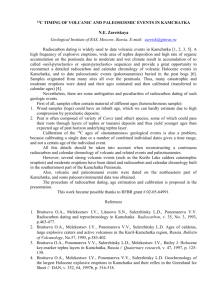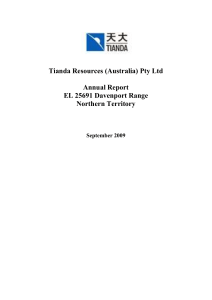volcanism and structure of south
advertisement
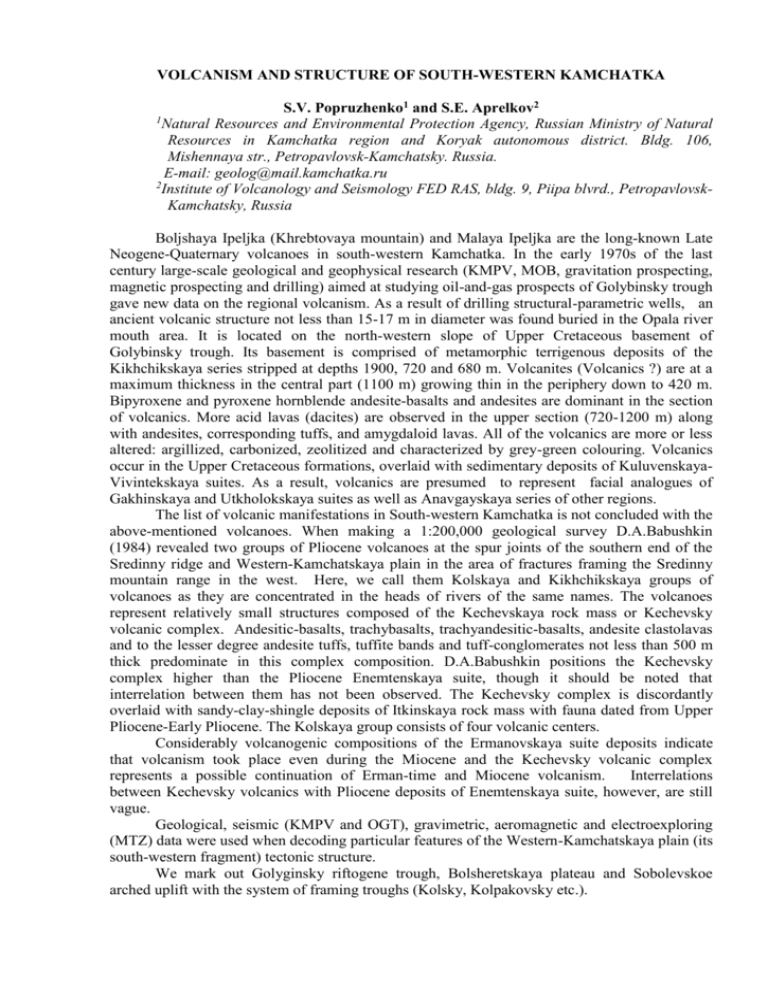
VOLCANISM AND STRUCTURE OF SOUTH-WESTERN KAMCHATKA S.V. Popruzhenko1 and S.E. Aprelkov2 1 Natural Resources and Environmental Protection Agency, Russian Ministry of Natural Resources in Kamchatka region and Koryak autonomous district. Bldg. 106, Mishennaya str., Petropavlovsk-Kamchatsky. Russia. E-mail: geolog@mail.kamchatka.ru 2 Institute of Volcanology and Seismology FED RAS, bldg. 9, Piipa blvrd., PetropavlovskKamchatsky, Russia Boljshaya Ipeljka (Khrebtovaya mountain) and Malaya Ipeljka are the long-known Late Neogene-Quaternary volcanoes in south-western Kamchatka. In the early 1970s of the last century large-scale geological and geophysical research (KMPV, MOB, gravitation prospecting, magnetic prospecting and drilling) aimed at studying oil-and-gas prospects of Golybinsky trough gave new data on the regional volcanism. As a result of drilling structural-parametric wells, an ancient volcanic structure not less than 15-17 m in diameter was found buried in the Opala river mouth area. It is located on the north-western slope of Upper Cretaceous basement of Golybinsky trough. Its basement is comprised of metamorphic terrigenous deposits of the Kikhchikskaya series stripped at depths 1900, 720 and 680 m. Volcanites (Volcanics ?) are at a maximum thickness in the central part (1100 m) growing thin in the periphery down to 420 m. Bipyroxene and pyroxene hornblende andesite-basalts and andesites are dominant in the section of volcanics. More acid lavas (dacites) are observed in the upper section (720-1200 m) along with andesites, corresponding tuffs, and amygdaloid lavas. All of the volcanics are more or less altered: argillized, carbonized, zeolitized and characterized by grey-green colouring. Volcanics occur in the Upper Cretaceous formations, overlaid with sedimentary deposits of KuluvenskayaVivintekskaya suites. As a result, volcanics are presumed to represent facial analogues of Gakhinskaya and Utkholokskaya suites as well as Anavgayskaya series of other regions. The list of volcanic manifestations in South-western Kamchatka is not concluded with the above-mentioned volcanoes. When making a 1:200,000 geological survey D.A.Babushkin (1984) revealed two groups of Pliocene volcanoes at the spur joints of the southern end of the Sredinny ridge and Western-Kamchatskaya plain in the area of fractures framing the Sredinny mountain range in the west. Here, we call them Kolskaya and Kikhchikskaya groups of volcanoes as they are concentrated in the heads of rivers of the same names. The volcanoes represent relatively small structures composed of the Kechevskaya rock mass or Kechevsky volcanic complex. Andesitic-basalts, trachybasalts, trachyandesitic-basalts, andesite clastolavas and to the lesser degree andesite tuffs, tuffite bands and tuff-conglomerates not less than 500 m thick predominate in this complex composition. D.A.Babushkin positions the Kechevsky complex higher than the Pliocene Enemtenskaya suite, though it should be noted that interrelation between them has not been observed. The Kechevsky complex is discordantly overlaid with sandy-clay-shingle deposits of Itkinskaya rock mass with fauna dated from Upper Pliocene-Early Pliocene. The Kolskaya group consists of four volcanic centers. Considerably volcanogenic compositions of the Ermanovskaya suite deposits indicate that volcanism took place even during the Miocene and the Kechevsky volcanic complex represents a possible continuation of Erman-time and Miocene volcanism. Interrelations between Kechevsky volcanics with Pliocene deposits of Enemtenskaya suite, however, are still vague. Geological, seismic (KMPV and OGT), gravimetric, aeromagnetic and electroexploring (MTZ) data were used when decoding particular features of the Western-Kamchatskaya plain (its south-western fragment) tectonic structure. We mark out Golyginsky riftogene trough, Bolsheretskaya plateau and Sobolevskoe arched uplift with the system of framing troughs (Kolsky, Kolpakovsky etc.). On the basis of geophysical characteristics of famous volcanoes according to distinct geophysical anomalies, the regions with an estimated occurrence of buried Late Cenozoic paleovolcanoes (Fig.1) are distinguished. Conclusions: 1. Paleovolcanism manifestations in the south-western Kamchatka territory are the echo or consequence of violent volcanic activity which took place to the east in the Central Kamchatsky volcanic belt (CKVB) during Oligocene-Pleistocene. They cannot be related to the CKVB, however, as volcanism developed under different structural conditions, i.e. within the boundary of other regional structures. 2. During the Late Cenozoic the area of the recent Western Kamchatskaya lowland was characterized by volcanism. It is connected with the formation of a riftogene trough and the magmotectonic activation of the Bolsheretskaya plateau as well as, possibly, the Sobolevskoe arched uplift. 3. Apparently, manifestations of volcanism are paragenetically connected with development of structure-controlling fractures of the upthrown-fault type over the regional structure boundaries and local hearth zones of extension at intersection knots of «secondary» order ruptures within the areas of maximum downwarping. 4. In a practical asspect, oil-and-gas prospects in Golyginsky trough should be concurrent with, the wider development of volcanics within its boundary. In addition, the occurrence of buried volcanoes may also explain the intense clogging of Cenozoic sedimentary cover with tufogene material.
